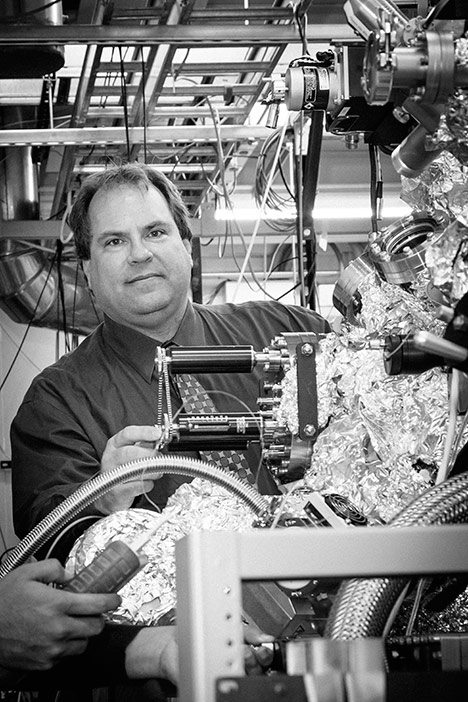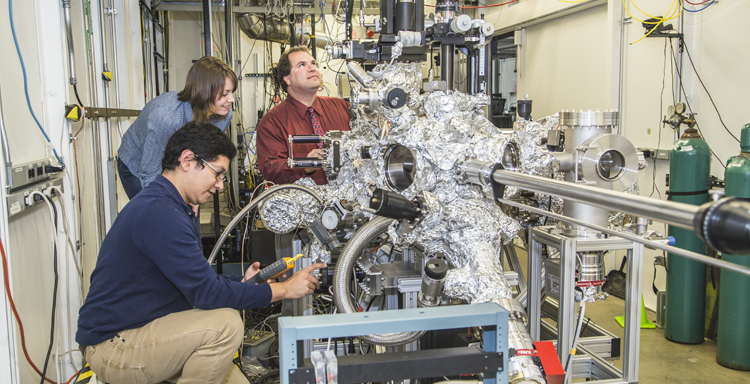
Toward Safer Nuclear Solutions
As a second-grader, Jeff Terry hoped to one day be a nuclear chemist. But as a young adult he fought against the Bailly Nuclear Power Plant, a failed project (construction began in 1974 and was canceled in 1981) planned for the Indiana Dunes National Lakeshore, because he feared it would kill the fish in Lake Michigan. During graduate school, however, he again had a change of heart.
“I started looking at the growing population and realized the only thing that could bring most of the world out of energy poverty, without cooking us through climate change, was nuclear energy,” says Terry, now an Illinois Tech physics professor and nuclear proponent.
Today he’s helping to make the resource as safe as possible.
Trained as a physical chemist, Terry spent his early career working in the United States Department of Energy Stockpile Stewardship and Management Program at Los Alamos National Laboratory. Today, along with his faculty duties, he is the technical lead for synchrotron radiation experiments that the Nuclear Science User Facility (NSUF) conducts at Illinois Tech’s Materials Research Collaborative Access Team at the Advanced Photon Source in Argonne, Illinois. Terry is an expert in synchrotron radiation techniques that utilize photons to help determine the chemical properties of irradiated materials, which he’s using for his latest project: an effort to develop safer nuclear fuels.

Photo: Michael Goss
He and his students are studying whether silicon carbide might be a safer choice than zirconium when used as a nuclear fuel cladding, the layers of material used to keep radioactive fission products from escaping during reactor operations. Cladding failure came into the spotlight in 2011 following the 9.0 earthquake and subsequent tsunami that caused a loss-of-coolant accident (LOCA) at Japan’s Fukushima Daiichi Nuclear Power Station. Zirconium alloy cladding at Fukushima reacted with steam to create hydrogen, which built up and exploded.
Since silicon carbide has been proposed as fuel cladding in more advanced reactors, Terry and his collaborative partners at Oak Ridge National Laboratory (ORNL) chose to test whether it could be used in light water reactors like that at Fukushima.
To answer that question, they have fabricated model silicon carbide films and are comparing the physical and chemical properties of those films with that of silicon carbide cladding that was irradiated in a test reactor. They compare the irradiated claddings with others that have been tested under extremes that mimic accident conditions. The data they collect will help refine current predictive models used to anticipate and prevent nuclear accidents and will inform the development of potential new cladding materials. So far, the silicon carbide cladding appears to work as well as the currently used zirconium alloy while greatly minimizing the risk of a hydrogen explosion.
“By understanding what’s going on, you can fine-tune your engineering solutions to limit transport and release; you can also have very good predictive behavior about what might be the extent of release under a specific scenario,” says Kurt Terrani, staff scientist in ORNL’s Nuclear Fuel Materials Group. “The work is quite sophisticated, and Jeff and the students’ personal dedication level has been immense.”
Two NSUF project awards have allowed the team to complete its study of the material’s chemical properties; next they will use electron microscopy to study its physical properties, including the presence of any cracks that could allow radioactive materials to leak out. His group has also explored other potential cladding substitutes, including zirconium carbide and zirconium nitride.
When or if any of the potential substitutes will be placed in actual reactors, however, remains unknown because of the lack of clear guidelines from the Nuclear Regulatory Commission.
“The goal is to provide enough information to get the fuel qualified for use in light water reactors, but obtaining NRC approval is such an open-ended process that no one is actually sure when that might happen,” Terry says.
More Online
Materials Research Collaborative Access Team: http://mrcat.iit.edu
Oak Ridge National Laboratory Nuclear Science Research: www.ornl.gov/science-area/nuclear-sciences